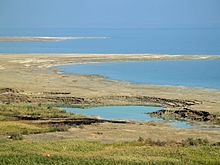Wakerley woodland is known to contain numerous naturally occuring swallowholes or sinkholes, please keep to the main tracks or waymarked trails.
A sinkhole, also known as a sink, sink-hole, shakehole, swallet, swallow hole, or doline (the different terms for sinkholes are often used interchangeably), is a depression or hole in the ground caused by some form of collapse of the surface layer. Some are caused by karst processes—for example, the chemical dissolution of carbonate rock or suffosion processes. Sinkholes may vary in size from 1 to 600 m (3.3 to 2,000 ft) both in diameter and depth, and vary in form from soil-lined bowls to bedrock-edged chasms. Sinkholes may be formed gradually or suddenly, and are found worldwide.
Formation

Sinkholes near the
Dead Sea, formed when underground salt is dissolved by freshwater intrusion, due to continuing sea-level drop.
Natural processes
Sinkholes may capture surface drainage from running or standing water, but may also form in high and dry places in specific locations.
The formation of sinkholes involves natural processes of erosion or gradual removal of slightly soluble bedrock (such as limestone) by percolating water, the collapse of a cave roof, or a lowering of the water table. Sinkholes often form through the process of suffosion. Thus, for example, groundwater may dissolve the carbonate cement holding the sandstone particles together and then carry away the lax particles, gradually forming a void.
Occasionally a sinkhole may exhibit a visible opening into a cave below. In the case of exceptionally large sinkholes, such as the Minyé sinkhole in Papua New Guinea or Cedar Sink at Mammoth Cave National Park in Kentucky, an underground stream or river may be visible across its bottom flowing from one side to the other.
Sinkholes are common where the rock below the land surface is limestone or other carbonate rock, salt beds, or in other rocks, such as gypsum, that can be dissolved naturally by circulating ground water. Sinkholes also occur in sandstone and quartzite terrains.
As the rock dissolves, spaces and caverns develop underground. These sinkholes can be dramatic, because the surface land usually stays intact until there is not enough support. Then, a sudden collapse of the land surface can occur.
Artificial processes

Sinkhole formed by rainwater leaking through pavement and carrying soil into a ruptured sewer pipe.
Sinkholes also form from human activity, such as the rare collapse of abandoned mines and salt cavern storage in salt domes in places like Louisiana, Mississippi and Texas. More commonly, sinkholes occur in urban areas due to water main breaks or sewer collapses when old pipes give way. They can also occur from the overpumping and extraction of groundwater and subsurface fluids.
Sinkholes can also form when natural water-drainage patterns are changed and new water-diversion systems are developed. Some sinkholes form when the land surface is changed, such as when industrial and runoff-storage ponds are created; the substantial weight of the new material can trigger an underground collapse of supporting material, thus causing a sinkhole.
To log this Earthcache:
Go to the published Co-ords and answer the following questions and send your answers to me through email in profile, please don't wait for a reply before you log your find:
1. What are the approximate dimensions of the sink hole?
2. Do you think this Sink hole was naturally forming or artificial?
3. What can you see (or not see) nearby to justify your answer to Q2?
4. Please post a photo of you at GZ (optional)
